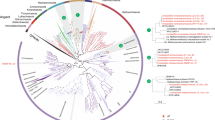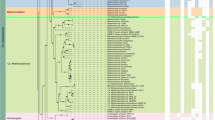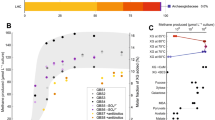Abstract
Methanogenesis is an ancient metabolism of key ecological relevance, with direct impact on the evolution of Earth’s climate. Recent results suggest that the diversity of methane metabolisms and their derivations have probably been vastly underestimated. Here, by probing thousands of publicly available metagenomes for homologues of methyl-coenzyme M reductase complex (MCR), we have obtained ten metagenome-assembled genomes (MAGs) belonging to potential methanogenic, anaerobic methanotrophic and short-chain alkane-oxidizing archaea. Five of these MAGs represent under-sampled (Verstraetearchaeota, Methanonatronarchaeia, ANME-1 and GoM-Arc1) or previously genomically undescribed (ANME-2c) archaeal lineages. The remaining five MAGs correspond to lineages that are only distantly related to previously known methanogens and span the entire archaeal phylogeny. Comprehensive comparative annotation substantially expands the metabolic diversity and energy conservation systems of MCR-bearing archaea. It also suggests the potential existence of a yet uncharacterized type of methanogenesis linked to short-chain alkane/fatty acid oxidation in a previously undescribed class of archaea (‘Candidatus Methanoliparia’). We redefine a common core of marker genes specific to methanogenic, anaerobic methanotrophic and short-chain alkane-oxidizing archaea, and propose a possible scenario for the evolutionary and functional transitions that led to the emergence of such metabolic diversity.
This is a preview of subscription content, access via your institution
Access options
Access Nature and 54 other Nature Portfolio journals
Get Nature+, our best-value online-access subscription
$29.99 / 30 days
cancel any time
Subscribe to this journal
Receive 12 digital issues and online access to articles
$119.00 per year
only $9.92 per issue
Buy this article
- Purchase on Springer Link
- Instant access to full article PDF
Prices may be subject to local taxes which are calculated during checkout




Similar content being viewed by others
Data availability
MAG sequences are available in the BioProject PRJNA472146 and Biosamples SAMN10387997, SAMN10390728, SAMN10390732, SAMN10390733, SAMN10390735, SAMN10390736, SAMN10390737, SAMN10390738, SAMN10390739. NM2 sequences corresponding to markers reported in Table 2 are deposited under MK202738 to MK202758.
References
Demirel, B. & Scherer, P. The roles of acetotrophic and hydrogenotrophic methanogens during anaerobic conversion of biomass to methane: a review. Rev. Environ. Sci. Biotechnol. 7, 173–190 (2008).
Schink, B. Energetics of syntrophic cooperation in methanogenic degradation. Microbiol. Mol. Biol. Rev. 61, 262–280 (1997).
Ueno, Y., Yamada, K., Yoshida, N., Maruyama, S. & Isozaki, Y. Evidence from fluid inclusions for microbial methanogenesis in the early Archaean era. Nature 440, 516–519 (2006).
Sousa, F. L. et al. Early bioenergetic evolution.Philos. Trans. R Soc. Lond. B 368, 20130088 (2013).
Kasting, J. F. & Siefert, J. L. Life and the evolution of Earth’s atmosphere. Science 296, 1066–1068 (2002).
Bapteste, E., Brochier, C. & Boucher, Y. Higher-level classification of the Archaea: evolution of methanogenesis and methanogens. Archaea. 1, 353–363 (2005).
Whitman, W. B., Bowen, T. L. & Boone, D. R. The Methanogenic Bacteria. Prokaryotes Vol. 3 (Springer, New York, 2006); https://doi.org/10.1007/0-387-30743-5_9
Kendall, M. M. & Boone, D. R. in The Prokaryotes 244–256 (Springer, New York, 2006); https://doi.org/10.1007/0-387-30743-5_12
Oren, A. in The Prokaryotes: Other Major Lineages of Bacteria and The Archaea (eds Rosenberg, E. et al.) 165–193 (Springer, New York, 2014).
Borrel, G., Adam, P. S. & Gribaldo, S. Methanogenesis and the Wood-Ljungdahl pathway: an ancient, versatile, and fragile association. Genome Biol. Evol. 8, 1706–1711 (2016).
Timmers, P. H. A. et al. Reverse methanogenesis and respiration in Methanotrophic Archaea. Archaea 2017, 1654237 (2017).
Scheller, S., Ermler, U. & Shima, S. in Anaerobic Utilization of Hydrocarbons, Oils, and Lipids (ed. Bool, M.) 1–29 (Springer, Chamonix, 2017); https://doi.org/10.1007/978-3-319-33598-8_3-1.
Hallam, S. J. et al. Reverse methanogenesis: testing the hypothesis with environmental genomics. Science 305, 1457–1462 (2004).
Adam, P. S., Borrel, G., Brochier-Armanet, C. & Gribaldo, S. The growing tree of Archaea: new perspectives on their diversity, evolution and ecology. ISME. J. 11, 2407–2425 (2017).
Spang, A., Caceres, E. F. & Ettema, T. J. G. Genomic exploration of the diversity, ecology, and evolution of the archaeal domain of life. Science 357, pii: eaaf3883 (2017).
Borrel, G. et al. Phylogenomic data support a seventh order of methylotrophic methanogens and provide insights into the evolution of methanogenesis. Genome Biol. Evol. 5, 1769–1780 (2013).
Nobu, M. K., Narihiro, T., Kuroda, K., Mei, R. & Liu, W.-T. Chasing the elusive Euryarchaeota class WSA2: genomes reveal a uniquely fastidious methyl-reducing methanogen. ISME. J. 10, 2478–2487 (2016).
Sorokin, D. Y. et al. Discovery of extremely halophilic, methyl-reducing euryarchaea provides insights into the evolutionary origin of methanogenesis. Nat. Microbiol. 2, 17081 (2017).
Vanwonterghem, I. et al. Methylotrophic methanogenesis discovered in the novel archaeal phylum Verstraetearchaeota. Nat. Microbiol. 1, 16170 (2016).
Brugère, J. F. et al. Archaebiotics: proposed therapeutic use of archaea to prevent trimethylaminuria and cardiovascular disease. Gut Microbes 5, 5–10 (2014).
Laso-Pérez, R. et al. Thermophilic Archaea activate butane via alkyl-coenzyme M formation. Nature 539, 396–401 (2016).
Evans, P. N. et al. Methane metabolism in the archaeal phylum Bathyarchaeota revealed by genome-centric metagenomics. Science 350, 434–438 (2015).
Dombrowski, N., Seitz, K. W., Teske, A. P. & Baker, B. J. Genomic insights into potential interdependencies in microbial hydrocarbon and nutrient cycling in hydrothermal sediments.Microbiome 5, 106 (2017).
McKay, L. J., & Hatzenpichler, R., Inskeep, W. P. & Fields, M. W. Occurrence and expression of novel methyl-coenzyme M reductase gene (mcrA) variants in hot spring sediments. Sci. Rep. 7, 7252 (2017).
Hawley, E. R. et al. Metagenomes from two microbial consortia associated with Santa Barbara seep oil. Mar. Genomics 18, 97–99 (2014).
Seitz, K. W., Lazar, C. S., Hinrichs, K.-U., Teske, A. P. & Baker, B. J. Genomic reconstruction of a novel, deeply branched sediment archaeal phylum with pathways for acetogenesis and sulfur reduction. ISME. J. 10, 1696–1705 (2016).
Mckay, L. J. et al. Co-occurring genomic capacity for anaerobic methane and dissimilatory sulfur metabolisms discovered in the Korarchaeota. Nat. Microbiol. https://doi.org/10.1038/s41564-019-0362-4 (2019).
Ermler, U., Grabarse, W., Shima, S., Goubeaud, M. & Thauer, R. K. Crystal structure of methyl-coenzyme M reductase: the key enzyme of biological methane formation. Science 278, 1457–1462 (1997).
Arshad, A. et al. A metagenomics-based metabolic model of nitrate-dependent anaerobic oxidation of methane by Methanoperedens-like archaea. Front. Microbiol. 6, 1423 (2015).
Wegener, G., Krukenberg, V., Riedel, D., Tegetmeyer, H. E. & Boetius, A. Intercellular wiring enables electron transfer between methanotrophic archaea and bacteria. Nature 526, 587–590 (2015).
McGlynn, S. E., Chadwick, G. L., Kempes, C. P. & Orphan, V. J. Single cell activity reveals direct electron transfer in methanotrophic consortia. Nature 526, 531–535 (2015).
Meyerdierks, A. et al. Metagenome and mRNA expression analyses of anaerobic methanotrophic archaea of the ANME-1 group. Environ. Microbiol. 12, 422–439 (2010).
Grimaldi, S., Schoepp-Cothenet, B., Ceccaldi, P., Guigliarelli, B. & Magalon, A. The prokaryotic Mo/W-bisPGD enzymes family: a catalytic workhorse in bioenergetic. Biochim. Biophys. Acta Bioenerg. 1827, 1048–1085 (2013).
Jormakka, M. et al. Molecular mechanism of energy conservation in polysulfide respiration. Nat. Struct. Mol. Biol. 15, 730–737 (2008).
Hagemeier, C. H., Chistoserdova, L., Lidstrom, M. E., Thauer, R. K. & Vorholt, J. A. Characterization of a second methylene tetrahydromethanopterin dehydrogenase from Methylobacterium extorquens AM1. Eur. J. Biochem. 267, 3762–3769 (2000).
McInerney, M. J. et al. The genome of Syntrophus aciditrophicus: life at the thermodynamic limit of microbial growth. Proc. Natl Acad. Sci. USA 104, 7600–7605 (2007).
Klenk, H.-P. et al. The complete genome sequence of the hyperthermophilic, sulphate-reducing archaeon Archaeoglobus fulgidus. Nature 390, 364–370 (1997).
Milkov, A. V. Molecular and stable isotope compositions of natural gas hydrates: a revised global dataset and basic interpretations in the context of geological settings. Org. Geochem. 36, 681–702 (2005).
Meredith, W., Kelland, S. J. & Jones, D. M. Influence of biodegradation on crude oil acidity and carboxylic acid composition. Org. Geochem. 31, 1059–1073 (2000).
Sieber, J. R., McInerney, M. J. & Gunsalus, R. P. Genomic insights into syntrophy: the paradigm for anaerobic metabolic cooperation. Annu. Rev. Microbiol. 66, 429–452 (2012).
Zengler, K., Richnow, H. H., Rosselló-Mora R., Michaelis, W. & Widdel, F. Methane formation from long-chain alkanes by anaerobic microorganisms. Nature 401, 266–269, https://doi.org/10.1038/45777 (1999).
Stams, A. J. M., Sousa, D. Z., Kleerebezem, R. & Plugge, C. M. Role of syntrophic microbial communities in high-rate methanogenic bioreactors. Water Sci. Technol. 66, 353–363 (2012).
Gao, B. & Gupta, R. S. Phylogenomic analysis of proteins that are distinctive of Archaea and its main subgroups and the origin of methanogenesis. BMC Genomics 8, 86 (2007).
Kaster, A. K. More than 200 genes required for methane formation from H2 and CO2 and energy conservation are present in Methanothermobacter marburgensis and Methanothermobacter thermautotrophicus. Archaea 2011, 973848 (2011).
Nayak, D. D., Mahanta, N., Mitchell, D. A. & Metcalf, W. W. Post-translational thioamidation of methyl-coenzyme M reductase, a key enzyme in methanogenic and methanotrophic archaea. eLife 6, e29218 (2017).
Lyu, Z. et al. Mmp10 is required for post-translational methylation of arginine at the active site of methyl-coenzyme M reductase. Preprint at BioRxiv https://doi.org/10.1101/211441 (2017).
Sarmiento, F., Mrázek, J. & Whitman, W. B. Genome-scale analysis of gene function in the hydrogenotrophic methanogenic archaeon Methanococcus maripaludis. Proc. Natl Acad. Sci. USA 110, 4726–4731 (2013).
Wagner, T., Kahnt, J., Ermler, U. & Shima, S. Didehydroaspartate modification in methyl-coenzyme M reductase catalyzing methane formation. Angew. Chemie - Int. Ed. 55, 10630–10633 (2016).
Borrel, G. et al. Comparative genomics highlights the unique biology of Methanomassiliicoccales, a Thermoplasmatales-related seventh order of methanogenic archaea that encodes pyrrolysine. BMC Genomics 15, 679 (2014).
Zheng, K., Ngo, P. D., Owens, V. L., Yang, X. & Mansoorabadi, S. O. The biosynthetic pathway of coenzyme F430 in methanogenic and methanotrophic archaea. Science 354, 339–342 (2016).
Prakash, D., Wu, Y., Suh, S. J. & Duin, E. C. Elucidating the process of activation of methyl-coenzyme M reductase. J. Bacteriol. 196, 2491–2498 (2014).
Li, J. et al. Global mapping transcriptional start sites revealed both transcriptional and post-transcriptional regulation of cold adaptation in the methanogenic archaeon Methanolobus psychrophilus. Sci. Rep. 5, 9209 (2015).
Raymann, K., Brochier-Armanet, C. & Gribaldo, S. The two-domain tree of life is linked to a new root for the Archaea. Proc. Natl Acad. Sci. USA 112, 6670–6675 (2015).
Weiss, M. C. et al. The physiology and habitat of the last universal common ancestor. Nat. Microbiol. 1, 16116 (2016).
Adam, P. S., Borrel, G. & Gribaldo, S. Evolutionary history of carbon monoxide dehydrogenase/acetyl-CoA synthase, one of the oldest enzymatic complexes. Proc. Natl Acad. Sci. USA 115, E5837 (2018).
McGlynn, S. E. Energy metabolism during anaerobic methane oxidation in ANME Archaea. Microbes Environ. 32, 5–13 (2017).
Katoh, K. & Standley, D. M. MAFFT multiple sequence alignment software version 7: improvements in performance and usability. Mol. Biol. Evol. 30, 772–780 (2013).
Criscuolo, A. & Gribaldo, S. BMGE (block mapping and gathering with entropy): a new software for selection of phylogenetic informative regions from multiple sequence alignments. BMC Evol. Biol. 10, 210 (2010).
Nguyen, L. T., Schmidt, H. A., Von Haeseler, A. & Minh, B. Q. IQ-TREE: a fast and effective stochastic algorithm for estimating maximum-likelihood phylogenies. Mol. Biol. Evol. 32, 268–274 (2015).
Nurk, S., Meleshko, D., Korobeynikov, A. & Pevzner, P. A. MetaSPAdes: a new versatile metagenomic assembler. Genome Res. 27, 824–834 (2017).
Peng, Y., Leung, H. C. M., Yiu, S.-M. & Chin, F. Y. L. IDBA-UD: a de novo assembler for single-cell and metagenomic sequencing data with highly uneven depth. Bioinformatics 28, 1420–1428 (2012).
Kang, D. D., Froula, J., Egan, R. & Wang, Z. MetaBAT, an efficient tool for accurately reconstructing single genomes from complex microbial communities. Peer J. 3, e1165 (2015).
Wu, Y. W., Simmons, B. A. & Singer, S. W. MaxBin 2.0: an automated binning algorithm to recover genomes from multiple metagenomic datasets. Bioinformatics 32, 605–607 (2015).
Alneberg, J. et al. Binning metagenomic contigs by coverage and composition. Nat. Methods 11, 1144–1146 (2014).
Sieber, C. M. K. et al. Recovery of genomes from metagenomes via a dereplication, aggregation, and scoring strategy. Nat. Microbiol. 3, 836–843 (2018).
Parks, D. H., Imelfort, M., Skennerton, C. T., Hugenholtz, P. & Tyson, G. W. CheckM: assessing the quality of microbial genomes recovered from isolates, single cells, and metagenomes. Genome Res. 25, 1043–1055 (2015).
Darling, A. E. et al. PhyloSift: phylogenetic analysis of genomes and metagenomes. Peer J. 2, e243 (2014).
Kobert, K., Salichos, L., Rokas, A. & Stamatakis, A. Computing the internode certainty and related measures from partial gene trees. Mol. Biol. Evol. 33, 1606–1617 (2016).
Stamatakis, A. RAxML-VI-HPC: maximum likelihood-based phylogenetic analyses with thousands of taxa and mixed models. Bioinformatics 22, 2688–2690 (2006).
Lartillot, N., Lepage, T. & Blanquart, S. PhyloBayes 3: a Bayesian software package for phylogenetic reconstruction and molecular dating. Bioinformatics 25, 2286–2288 (2009).
Hyatt, D. et al. Prodigal: prokaryotic gene recognition and translation initiation site identification. BMC Bioinformatics 11, 119 (2010).
Aziz, R. K. et al. The RAST server: rapid annotations using subsystems technology. BMC Genomics 9, 75 (2008).
Oberto, J. SyntTax: a web server linking synteny to prokaryotic taxonomy. BMC Bioinformatics 14, 4 (2013).
Marchler-Bauer, A. et al. CDD: NCBI’s conserved domain database. Nucleic Acids Res. 43, D222–D226 (2015).
Abby, S. S., Néron, B., Ménager, H., Touchon, M. & Rocha, E. P. A. MacSyFinder: a program to mine genomes for molecular systems with an application to CRISPR-Cas systems.PLoS One 9, e110726(2014).
Kahnt, J. et al. Post-translational modifications in the active site region of methyl-coenzyme M reductase from methanogenic and methanotrophic archaea. FEBS. J. 274, 4913–4921 (2007).
Acknowledgements
We thank R. Thauer for feedback on an earlier version of the manuscript. G.B. acknowledges support from the Institut Pasteur through a Roux-Cantarini fellowship. P.S.A. is supported by a PhD fellowship from Paris Diderot University and by funds from the PhD Programme ‘Frontières du Vivant (FdV)-Programme Bettencourt’. S.G. acknowledges funding from the French National Agency for Research Grant ArchEvol (No. ANR-16-CE02-0005-01). This work used the computational and storage services (TARS cluster) provided by the IT department at Institut Pasteur, Paris. S.J.H. acknowledges support from the US Department of Energy (DOE) JGI supported by the Office of Science of US DOE Contract No. DE-AC02–05CH11231, the Natural Sciences and Engineering Research Council (NSERC) of Canada, Genome British Columbia, Genome Canada, Canada Foundation for Innovation (CFI) and the Tula Foundation. I.N.S.-G. and V.M.d.O. are grateful to São Paulo Research Foundation—FAPESP (process Nos. 2011/14501-6 and 2013/20436-8) and Petrobras for financial support and to N. Gray and I. Head from the School of Civil Engineering and Geosciences at Newcastle University for lab facilities. W-J.L. was supported by Key Projects of Ministry of Science and Technology (MOST) (Nos. 2013DFA31980 and 2015FY110100). G.M. was supported by the ERC Advanced Grant PARASOL (No. 322551). L.J.M. appreciates funding from the NASA Postdoctoral Programme through the NASA Astrobiology Institute and W.P.I. was supported by the Montana Agricultural Experiment Station (Project No. 911300).
Author information
Authors and Affiliations
Contributions
G.B. and S.G. conceived the study. L.J.M., L-X.C., I.N.S.-G., C.M.K.S., G.L.A., W.-J.L., S.J. H., G.M., V.M.d.O., W.P.I. and J.F.B. sequenced and assembled the metagenomes. G.B. screened the IMG database for McrA and identified these metagenomes. Q.L., A.G. and G.B. developed the pipeline Let-it-bin. G.B. performed the contig binning of NM1a, NM1b, NM2, NM3, NM4, Verst-YHS, and Mnatro-ASL MAGs. L-X.C. carried out the contig binning of ANME-1-THS MAG and C.M.K.S. those of GoM-Arc1-GOS and ANME-2c MAGs. G.B. inferred the metabolism associated to each MAG and performed all phylogenetic analyses. P.S.A. performed the congruence tests. G.B. and S.G. wrote the manuscript. All authors read and commented on the manuscript.
Corresponding authors
Ethics declarations
Competing interests
The authors declare no competing interests.
Additional information
Publisher’s note: Springer Nature remains neutral with regard to jurisdictional claims in published maps and institutional affiliations.
Supplementary information
Supplementary Information
Supplementary Discussion, Supplementary References, Legends for Supplementary Tables, Supplementary Table 2, Supplementary Table 4, Supplementary Table 5, and Supplementary Figures 1–13.
Supplementary Table 1
Presence/absence of genes involved in specific substrate utilization, energy metabolism, cofactor biosynthesis, secretion, sulfate assimilation, N2 fixation, dissimilatory reduction of inorganic compounds and motility. Pathways and systems are subdivided into different spreadsheets. In each spreadsheet and for each metagenome-assembled genome, protein accession numbers with the same colour indicate co-localized genes.
Supplementary Table 3
Occurrence in archaea of 38 genes previously suggested to be methanogenesis markers.
Supplementary Table 6
Genomes used to build the archaea reference tree (Fig. 1). The first spreadsheet shows the number of genomes available and selected for the phylogeny, and the second spreadsheet gives the NCBI accession numbers (if any) of the selected genomes.
Rights and permissions
About this article
Cite this article
Borrel, G., Adam, P.S., McKay, L.J. et al. Wide diversity of methane and short-chain alkane metabolisms in uncultured archaea. Nat Microbiol 4, 603–613 (2019). https://doi.org/10.1038/s41564-019-0363-3
Received:
Accepted:
Published:
Issue Date:
DOI: https://doi.org/10.1038/s41564-019-0363-3
This article is cited by
-
The majority of microorganisms in gas hydrate-bearing subseafloor sediments ferment macromolecules
Microbiome (2023)
-
Well-hidden methanogenesis in deep, organic-rich sediments of Guaymas Basin
The ISME Journal (2023)
-
A compendium of viruses from methanogenic archaea reveals their diversity and adaptations to the gut environment
Nature Microbiology (2023)
-
Mcr-dependent methanogenesis in Archaeoglobaceae enriched from a terrestrial hot spring
The ISME Journal (2023)
-
Diversity and function of methyl-coenzyme M reductase-encoding archaea in Yellowstone hot springs revealed by metagenomics and mesocosm experiments
ISME Communications (2023)



